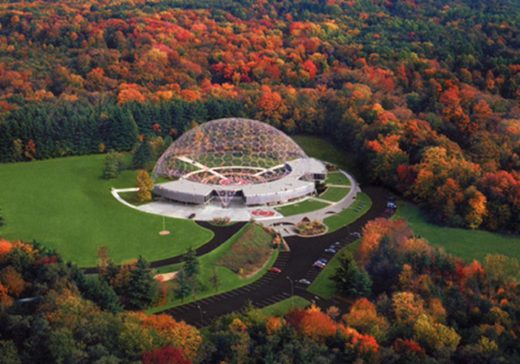Buckminster Fuller, the visionary that viewed architecture with a wide pair of lenses, Modern architectural design
Buckminster Fuller The Visionary of Architecture
9 May 2024
If you are an architecture student or are planning to dive into this career route then you need to know the name ‘Richard Buckminster Fuller’. R. Buckminster Fuller as he referred to himself wasn’t your ordinary architect or thinker. He was a maverick, a lifelong thinker and visionary who saw the need to build simpler things and more efficiently.
Buckminster Fuller – The Visionary That Viewed Architecture With a Wide Pair of Lenses
- Buckminster Fuller is intrinsically tied to the field of modern, contemporary architecture. His ideas continue to shape our world today, decades after his passing. If you’re an architecture student or enthusiast curious about Buckminster Fuller, this article is right up your alley. Let’s dive right in!
What Is Buckminster Fuller Known For?
That sounds like a question that you would answer in an essay or research question. If you’re looking to craft a superb essay on Buckminster Fuller then you’re in the right place. This article will be your starting guide, But, you can also use trusted paper writing services to craft high-quality papers that fully capture the essence of your research.
- Buckminster Fuller was best known for designing and patenting the Geodesic Dome. A geodesic dome is a hemispherical, lightweight structure made of polygonal lattices. The skeletal truss is entirely in tension and thus, the structure doesn’t need wide members, not to mention being lightweight.
Thus, R. Buckminster Fuller was able to tackle one of key the problems faced in engineering and architecture, i.e., that of heavily loaded structures. The geodesic structures were incredibly strong and lightweight compared to the volume of material used.
Other useful byproducts of this structure included:
- Reduced exposure to winter and heat due to the spherical shape.
- Natural airflow due to the concave interior.
- Acting like a giant reflector and concentrating the heat inside.
- Reduced turbulence due to wind flow.
One key importance of geodesic structures was the ability to build large spans without the need for internal columns. Thus, the inside of such a structure could be utilized more efficiently than traditional structures.
Buckminster Fuller’s Philosophy
Buckminster Fuller’s principle was “do more with less”. He was nearly obsessed with efficiency as a design tool and principle. He believed in sustainability, meaning structures that had longevity, could fulfill the design loads and requirements, and reduce environmental impact. He also wanted the geodesic dome to be mass-produced as a form of low-cost housing.
Fuller’s ideas weren’t quickly accepted by the Architectural and scientific communities, but this didn’t stop him from moving with steam. He placed careful emphasis on studying and improving interior structure and elements such as the shower, toilet, and kitchen.
At the twilight of World War II, the United States was suffering from a housing crisis. With his prototype single unit family house built like the geodesic dome, Fuller was miles ahead of the competition. His design could be replicated for low-cost housing, installed anywhere and built quickly. Fuller’s domes further gained prominence and worldwide attention when the United States government contracted to produce his tension structure as a solution for low-cost homes.
Famous Structures Built or Inspired By Buckminster Fuller
The foundation of Fuller’s innovations was the geodesic dome. This would later be the inspiration for other famous structures around the world, including some designed and built by Fuller himself.
Let’s take a look at some of the famous structures inspired or built by Fuller himself.
The US Pavilion at Expo 67
This massive geodesic structure located in Montreal became the centerpiece of Fuller’s works and later became a science museum. The structure was 250-feet in diameter and was designed in collaboration with architect Shoji Sadao. This structure later came to be famously known as the Montreal Biosphere.
Materials Park ASM Ohio
The futuristic Materials Park located in Cleveland, Ohio, has been the headquarters of the American Society of Metals since 1959. Buckminster Fuller collaborated with various renowned architects and engineers to design and build the project.
The ASM dome is 250 feet in diameter and 103 feet in height. The structure is made from extruded aluminum, with three levels and 50,000 square feet of floor space.
The Dymaxion House
The Dymaxion House was Fuller’s proposed solution to the problem of mass housing that had gripped the U.S. The term “Dymaxion” combines three of Fuller’s favorite words and philosophies, i.e. DYnamic, MAXimum and tensION. The house was conceptualized in the 1920s but wasn’t built until 1945.
The Dymaxion House was designed to be completely self-sufficient and portable. The home was made to generate its power, and was earthquake and storm-proof. It was also made of superb quality engineering materials that needed no maintenance or even spare parts. Likewise, the structure would never need central heating and would store energy from the general design and materials used.
Charter Industries Dome
- Buckminster Fuller designed a modified geodesic dome as housing for army troops during and after the Second World War. The system was made of light aluminum tools that were connected to form an exoskeleton frame, with the various joints plugged in. The removable joints allowed for quick installation and dismantling.
The last remaining prototype of the dome is located at the Vitra Design Museum in Weil am Rhein in Germany.
Melbourne Rectangular Stadium
This structure that is still under construction in Melbourne Australia is the only one on the list that wasn’t designed by Fuller. But his geodesic dome was the inspiration for the exoskeleton of the structure that overlays a cantilever system.
Remember to reach out to trusted essay writing services that can help you write better papers faster. Head on to a masterpapers review to find out how professional writing services can assist you in writing superb papers.
Famous 20th Century Architect Engineer Conclusion
This wasn’t intended to be a deep dive into the life and times of R. Buckminster Fuller. Rather, the article aimed to introduce you to some of his work, his design ethos and principle, and his impact on the world even beyond architecture.
Fuller didn’t achieve global superstar status until decades later when the world started to appreciate his work. He had a clear vision of what he wanted to achieve. He cleaved to his ethos of “more for less” for his entire life and created transformative structures. These transcended entire fields from architecture, engineering, construction, social housing, and even the military.
Comments on this Buckminster Fuller – The Visionary That Viewed Architecture With a Wide Pair of Lenses article are welcome.
Architecture
Hotel Architectural Designs
Arctic TreeHouse Hotel, Rovaniemi, northern Finland
Design: Studio Puisto Architects
NHOW Hotel in Frankfurt, Germany
Interior Design: Rafael de La-Hoz Arquitectos
Maidla Nature Villa, Rapla county, Estonia
Design: b210 architects
Property Design
Contemporary Property Articles – architectural selection below:
Comments / photos for the Buckminster Fuller – The Visionary That Viewed Architecture With a Wide Pair of Lenses article welcome.







